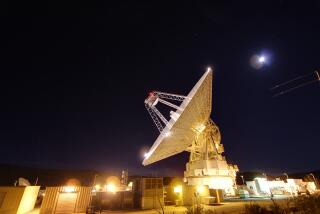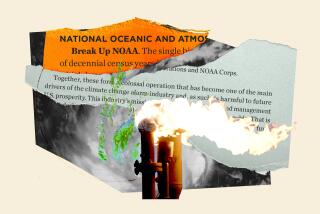Solar scientists call for better space weather forecasts
- Share via
A panel of science experts has called for the creation of a larger and better equipped National Space Weather Program, citing the potentially catastrophic effects of extreme solar eruptions.
On Wednesday, members of the National Research Council released a report on solar and space physics that outlined a series of program recommendations for the next 10 years. Among their suggestions was rechartering the nation’s space weather program at a “higher, more important level,” according to report chairman Daniel Baker of the University of Colorado.
“Despite well-documented vulnerability of essential societal, economic and security services, space environment monitoring remains resource challenged,” the report stated. Authors recommended that the National Space Weather Program should hold a position within the executive office of the president and involve NASA to a greater degree.
While the sun constantly emits streams of plasma known as solar wind, it also releases billions of tons of matter in periodic bursts. This matter can trigger intense magnetic storms capable of disrupting power grids, communication networks and Global Positioning Systems.
By developing new sources of data collection in space and on Earth, a reorganized space weather agency could better monitor and predict solar eruptions that were capable of knocking out GPS satellite networks or of harming orbiting astronauts, authors said.
Currently, the National Oceanic and Atmospheric Administration is the primary source of space weather alerts. The report recommends that the space weather program be rechartered under the auspices of the White House’s National Science and Technology Council and should include the participation of the Office of Science and Technology and the Office of Management and Budget.
“The committee anticipates that it will take decades to achieve a space environment weather and climatology infrastructure,” the report says. “Thus, it is necessary to start immediately.”
The report, which is meant to advance scientific understanding of the sun, was drafted over 18 months and involved 85 solar and space physicists and space system engineers. Among its recommendations was that NASA continue with its current projects, such as the $1.25-billion Solar Probe Plus – a mission that committee Vice Chairman Thomas Zurbuchen of the University of Michigan called a “mission to hell and back.” The probe, which will launch in 2018, will travel within 3.7 million miles of the sun and experience temperatures of up to 2,600 degrees Fahrenheit.
The report urged expansion of NASA’s Explorer program and said it should receive an additional $70 million a year. The program, which dates back to NASA’s early days, involves smaller spacecraft that can be launched on a time scale of three to five years. Such spacecraft collect large amounts of data relative to the cost, and therefore deliver “tremendous bang for the buck,” Zurbuchen said.
The National Research Council has also recommended establishing a multiagency initiative that will better coordinate efforts to study the sun and the particles it emits. The initiative, called DRIVE, would promote the use of more satellites and Earth-based observation tools in the study of the sun and promote the field of space research among the young, among other efforts.
The study was sponsored by NASA and the National Science Foundation.







